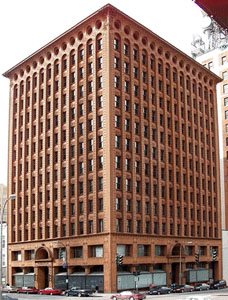- City in modernism
- Beginnings of an urban sociology
- City as a public and private space
- City in postmodernism
- Relation of the individual to the crowd in the city
Georg Simmel (1858-1918)
He is a German sociologist and he wrote Metropolis and Mental Life in 1903
It is an important essay
Dresden Exhibition 1903
Simmel is asked to lecture on the role intellectual life in the city but instead reverses the idea and writes about the effect of the city on the individual.
Public, employment, traffic, fine art etc were issues discussed
This was at a time that Freud was writing his lectures on analysis
Urban Sociology
The resistance of the individual to being levelled, swallowed up in the social-technological mechanism.
Louis Sullivan
He was an architect, and created the modern skyscraper. He mentored Frank Lloyd Wright. He coined the phrase 'form follows function' in an article about architecture. This phrase sums up what modernism is about, as it should be functional rather than decorative.

There is an organised design to the Guaranty building that he designed.
Skyscrapers represent the upwardly mobile city of business opportunity. Fire cleared buildings in Chicago in 1871 and made way for Louis Sullivan new aspirational buildings.
Charles Scheeler
Fordism
Industry in Detroit
Fordism: mechanised labour relations
Antonio Gramsci essay 1934
In the essay Americanism and Fordism he looks at the production line, where human bodies are used to create maximum productivity with minimal effort and create mechanical movements.
Modern Times, film by Charlie Chaplain
It's a critique of the idea of the production line. Character suffers a mental breakdown because he isn't good at the job
Stock market 1929
Crash
Factories closing, unemployment goes up
Margaret Bourke-White:
Flaneur
The term comes form the French word for stroller, lounger, loafer. Means 'to stroll'. A bourjois literay figure from the 19th century. Someone who walks around the city and experiences the city from a removed point of view, not a worker. He's not part of the mechanism and how the city works. Part of his role is to record what he says, whether in an artistic or literary way. French poet Charlies Baudelaire says 'He's a person who walks the city in order to experience it'
Walter Benjamin
Adpots the concept of the urban observer as an analytical and theoretical tool and as a lifestyle seen in his writings. The architecture arcades present an uninterrupted view of the city, which is protected from the weather and is an ideal place for the flaneur to walk about.
Photographer as a flaneur
The photographer is an armed version of the solitary walker connoitering, stalking, cruising the urban inferno, the voyeuristic stroller who discovers the city as a landscape of voluptuous extremes. Adept of the joys of watching, connoisseur of empathy, the flaneur finds the world 'picturesque' p55 Susan Sontag On Photography
Flaneuse
Susan Buck-Morss says the only type of women on the street is a prostitute or a bag lady
Sophie Calle Suite Venitienne 1980
Stalks this guy in Venice and takes photos of him without his knowledge, exploring female on male stalking in the city
The Detective 1980
She pays someone to follow her and take photographs of her existance, and she takes photographs of him as well. His photos and notes on her are displayed next to her photos and notes about him. Set in Paris
Here is New York Book/exhibition
Weegee
He had a darkroom in his van, and got to scenes before even the police had as he had a police radio in his van
Reported so many murders and crime scenes
Got there before any other photographers
The Naked City
It is a book of Weegee's photos, then a film was made about it.
Lorca di Corcia Heads
Sets up lights in the pavement so when people walk past it catches them and he takes photographs, so they almost look like film stills as they appear constructed. He did it in a lot of cities.
Walker Evans Many are Called
He has a camera under his coat on the subway, he takes photos of people who are unaware of being photographed.
Ed Soja The Postmodern City
John Meyerowitz Broadway and West 46th Street NY 1976


Leave your comment